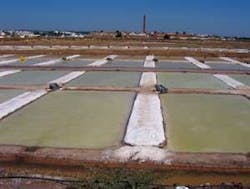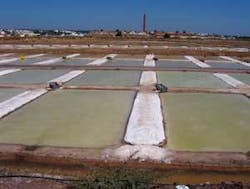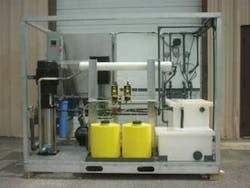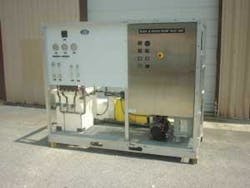Research Program to Examine Inland Desalination Technologies
By Rick Bond and Srinivas Veerapaneni
A new research project is underway to develop technologies that reduce the cost and energy consumption for inland desalination. The project, Zero Liquid Discharge and Volume Minimization for Inland Desalination, is jointly supported by the AWWA Research Foundation (AwwaRF) and the California Energy Commission. The research team includes scientists and engineers from Black & Veatch, the University of Kansas, the University of North Carolina, the University of Texas, Texas A&M University, and GE Betz Water Technologies.
During desalination, a waste concentrate stream is generated in addition to the desalted product water. Management of this concentrate is often the most challenging aspect of a desalination project. Common options for handling concentrate are direct discharge to surface water, deep well injection or further treatment to achieve zero liquid discharge (ZLD).
At coastal facilities, concentrate is typically discharged to the ocean. This option is not available at inland facilities, however, and the need to protect surface water and groundwater sources may preclude disposal into the environment. The alternative is ZLD, in which the concentrate is further treated to produce desalinated water and essentially dry salts.
The most common ZLD application in operation today is treatment of power plant cooling water using thermal desalination and/or evaporation ponds. Although design innovations over the years have optimized energy efficiency, thermal desalination remains an energy-intensive process due to the thermodynamic properties of water.
In previous research conducted by Black & Veatch for the Southern Nevada Water Authority (SNWA) on a brackish groundwater, it was estimated that the cost for thermal treatment of reverse osmosis (RO) concentrate using a mechanical vapor compression concentrator and a crystallizer was $3 per thousand gallons of total product water. This represented 70% of a total treatment cost that included production wells and RO membranes.
Energy requirements for evaporation ponds are minimal, but the protective liner and monitoring system required for groundwater protection result in construction costs that typically range from $100,000 to $200,000 per acre, excluding land cost. Furthermore, even in an arid climate, large land areas are required. An SNWA study estimated that handling one million gallons per day (mgd) of concentrate would require a 350-acre evaporation pond at a capital cost of $70 million - clearly not a viable solution. Another disadvantage is that water is lost in evaporation ponds. In the SNWA pilot study, the RO recovery was 63%, so 37% of the well production would be lost with the concentrate discharged to an evaporation pond.
Given the concentrate management challenges and the potentially high treatment costs, why are efforts underway to develop technologies for inland desalination? The answer is that many inland utilities across the United States are being confronted by growing water demands, increasing salt concentrations in their existing fresh water supplies, and contamination of fresh water supplies from brackish sources. For many of these utilities, the solution is desalination.
The guiding vision of the Desalination and Water Purification Technology Roadmap, produced by the Bureau of Reclamation and Sandia National Laboratories this year, is that by 2020 desalination will play a significant role in ensuring a "safe, sustainable, affordable, and adequate water supply for the United States."
The goal of the AwwaRF research project, Zero Liquid Discharge and Volume Minimization for Inland Desalination, is to develop a treatment technique that reduces energy consumption and treatment costs for inland desalination with zero liquid discharge. The research, launched September 1, 2004, will span two years. The utility partners in this effort are the Phoenix Water Services Department (AZ); SNWA; Scottsdale, AZ; Beverly Hills, CA; and San Antonio Water System (TX).
The research team will test brackish groundwater and reclaimed water provided by the project utility partners. The technical approach involves alternating applications of RO with precipitation processes designed to remove the least soluble salts under conditions of controlled mixing, salt seeding, chemical addition, residence time, temperature, and pH. After removing salts that limit recovery in the primary RO, concentrate will be treated in a secondary RO for further product water recovery and volume reduction. The research methodology will include computer modeling, bench-scale testing, and pilot-scale testing.
The test results will be used to develop a ZLD treatment process and to estimate the treatment costs for each of the water sources tested. The different water sources to be tested encompass a majority of inland brackish water characteristics. Hence, the research will provide guidance to water utilities seeking to implement desalination with ZLD, with solutions presented for varied water sources similar to those of many utilities.
The AwwaRF report, Zero Liquid Discharge and Volume Minimization for Inland Desalination, will be available in 2007.
"Sustainable water supply planning is an increasing challenge, and impaired sources like brackish groundwater can no longer be overlooked," said AwwaRF Project Manager Jennifer Warner. "This research will further the understanding of ZLD and help communities utilize impaired sources more effectively and economically."
About the Authors:
Rick Bond and Srinivas (Vasu) Veerapaneni are process engineers and treatment technology specialists in the Advanced Environmental Technologies Division of Black & Veatch (Kansas City, MO). Rick Bond can be reached at [email protected].



